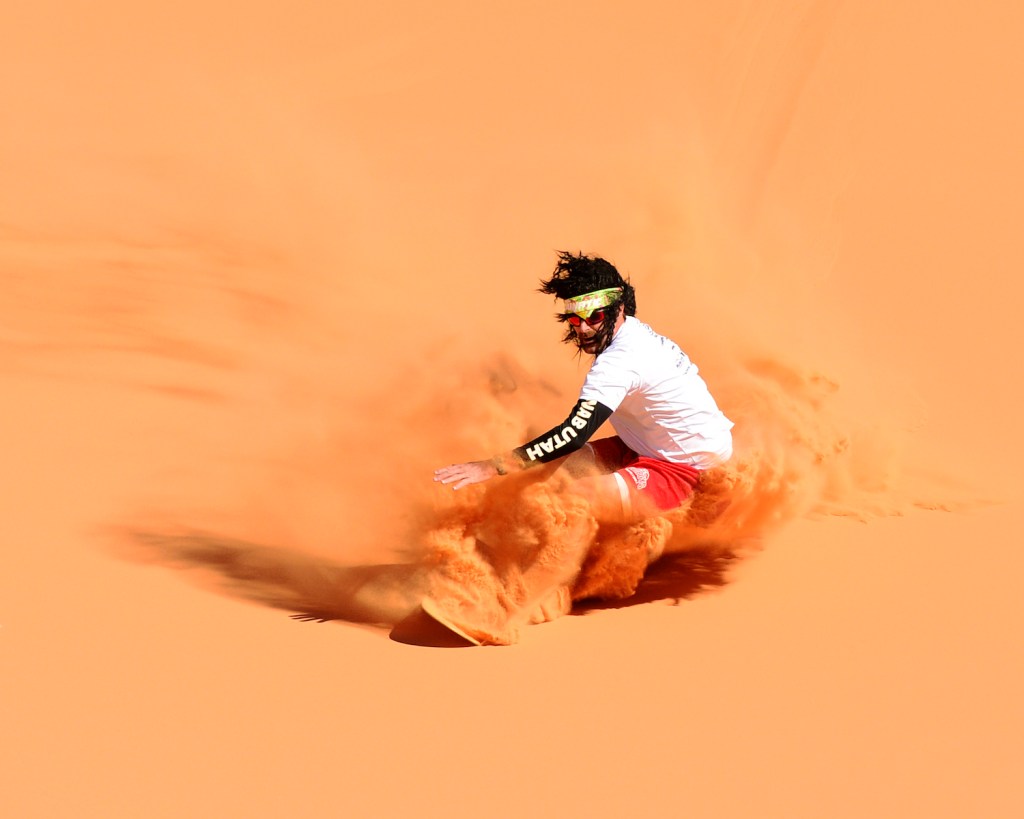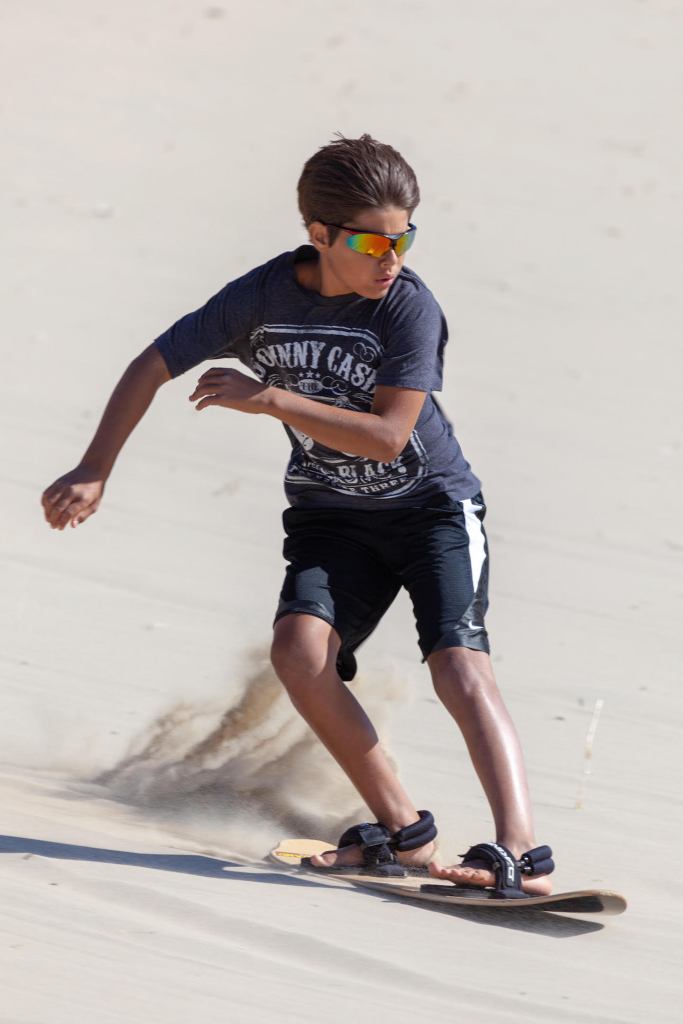Have you ever spotted a person zipping down a sand dune with a large board strapped to their feet? It looks like snowboarding or surfing, you might think to yourself, but there is no snow or water. What are they doing? If you guessed sandboarding, you are correct.
Sandboarding historians say the origins of sandboarding could date back to ancient Egypt, when people would slide down sand on pieces of wood or clay. But the niche board sport started gaining traction in the U.S. around the 1960s when adventurers climbing massive sand dunes in the Southwest wanted a quick, fun way to get down. They carried up cardboard, snow sleds, plastic saucers or pieces of metal to ride down—all with varying degrees of success.
“When I was in Boy Scouts, we used to go out to the dunes in Death Valley, California. We would ride anything we could find down those dunes,” said Lon Beale, one of the early pioneers of modern-day sandboarding. In 1991, Beale started manufacturing boards specifically for sandboarding and he eventually opened the world’s first sandboarding park in Florence, Oregon, in 2000.
The popularity of sandboarding has grown in recent years as snowboarders started hitting sandy slopes across southern Utah and Colorado during the off-season as a way to pass the time until winter returned. The lack of pricey lift tickets, crowded slopes and trees to avoid make the year-round sport potentially even more accessible than snowsports.
“Sandboarding has gotten more and more popular in the five years that we’ve offered it,” said Dean Anderson, assistant park manager at Utah’s Coral Pink Sand Dunes State Park, which sees around 10 to 20 sandboarders on a typical day. “I think the word is spreading, because people are coming here to the park just for this. Some of them are snowboarders, but a lot of them just think that sandboarding sounds like a cool thing to try.”

Utah’s Coral Pink Sand Dunes Park attracts over a dozen sandboarders each day. (Photo Credit: Kevin Orton)
In terms of technique and equipment, sandboarding parallels snowboarding. Both use a waxed board that requires heel-toe edge techniques to maneuver. Sandboarders, however, keep their weight on the back foot to accelerate instead of driving on the front foot like snowboarders.
“If you already snowboard, you are halfway there, but the properties of sand are more like a liquid, so it maneuvers and feels more like surfing,” Beale said. “When surfers come out, they get it in the first run. Snowboarders have to make some adjustments. It usually takes them a couple of runs before they get it.”
It’s a good idea to wear long pants and long-sleeved shirts to protect your skin from the sun and sand. Boards need to be waxed before each run to ensure a smooth ride. Drinking water is a must. Hiking sand dunes is no easy task, so remember to hydrate and rest when needed.
Parks across America are opening up their dunes to sandboarding and many have started to rent boards in response to the demand. Want to try it for yourself? Here are six of the best sand dunes in the U.S. for sandboarding.
Coral Pink Sand Dunes
Kanab, Utah
The 3,730 acres of uninterrupted sand dunes makes this Utah state park ripe for boarding. What sets this park apart from other dunes is the red hue of the sand. Over thousands of years, wind eroded grains from the surrounding red sandstone formations, leaving miles of salmon-colored sand. The scenery is so picturesque, the HBO Western-themed series Westworld is filmed here. Sandboarding at sunset while the fading light bounces off the pink sand is an absolute must.
Info: The park is open to boarding during daylight hours seven days a week; with around 90 percent of the dunes open to boarders. A day use fee for the park is $8 per vehicle and they rent boards for $25.

A rider at Oregon’s Sand Master Park, the world’s first sandboarding park. (Photo Credit: Lon Beale)
Sand Master Park
Florence, Oregon
Beale opened the world’s first sandboard park, Sand Master Park, in 2000. The 40-acre private park has sculpted sand dunes, a 40-foot ramp and a full-time pro shop. Classes are offered for newbie riders. If you’re lucky, champion borders will be on hand to offer expert advice. The park also hosts three competitive sandboarding events each year.
Info: Board rentals start at $10 a day and you can sign up for a lesson starting at $25 an hour. The park closes in January and February but is open seven days a week throughout the summer.
Great Sand Dunes National Park
Duncan, Colorado
Colorado is well known as a snowboarders’ paradise, but it’s also a haven for sandboarders. Great Sand Dunes National Park—between Denver and Albuquerque, New Mexico—has the tallest dunes in North America with the highest standing 750 feet tall. The park is great for snowboarders accustomed to bigger and longer runs.
Info: The park doesn’t rent sandboards, but several local shops do. Sandboarding is allowed anywhere on the dunes away from vegetated areas. A seven-day entrance pass to the park costs $25.
Monahans Sandhills State Park
Monahans, Texas
The 3,840-acre Monahans Sandhills State Park is just a fraction of the massive 200-mile long sand belt that extends from Texas into New Mexico. This west-Texas park is a magnet for landlocked surfers. The dunes are not as massive as those in Colorado, but at 70-feet high, sandboarders have plenty of incline to shred.
Info: You can rent sand disks, which are like plastic sleds or saucers, from the visitor’s center. Or bring your own board. Entrance to the park is $4 for adults and children 12 and under are free.
Kelso Dunes
Kelso, California
Forty-five miles of glistening rose quartz and feldspar comprise Kelso Dunes, the largest dunes in the Mojave National Preserve, five hours east of Los Angeles. The fine sand not only makes for great boarding, it’s also responsible for a rare acoustic phenomena known as “singing” sands. A low rumbling sound similar to a pipe organ can be heard as boarders slowly slide down the steepest dune faces.
Info: There is no entrance fee, no operating hours and no board rental on site at Mojave National Preserve.
Jockey’s Ridge State Park
Nags Head, North Carolina
Although most of America’s best sand dunes are out West, North Carolina’s Outer Banks has a few contenders. Jockey’s Ridge is the tallest dune system in the eastern United States, making it—according to Sandboarding Magazine—the best sandboarding location on the East Coast.
Info: Sandboarding is permitted in designated areas from October 1 to March 31 and you must get a free permit from the park office. A nearby shop rents sandboards for $20 for up to four hours or $40 for an entire day.
